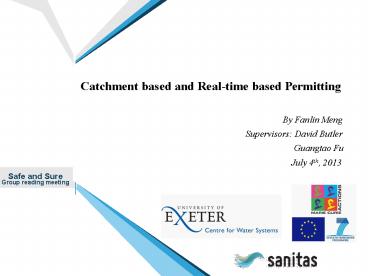PowerPoint Design Template - PowerPoint PPT Presentation
Title:
PowerPoint Design Template
Description:
... 2 Aims and objectives 3 Research proposals Outline Introduction Runoff Discharge Urban areas Industries Urban drainage systems CSOs ... anti-fouling biocide ... – PowerPoint PPT presentation
Number of Views:62
Avg rating:3.0/5.0
Title: PowerPoint Design Template
1
PowerPointDesign Template
Catchment based and Real-time based Permitting
By Fanlin Meng Supervisors David
Butler Guangtao Fu
- add your subheading
July 4th, 2013
2
Outline
3
Introduction
- Surface water pollution
Industries
Urban drainage systems
WWTP
Urban areas
Overflow from storm tanks
Effluent discharge
CSOs
Runoff
Discharge
Overflow
Receiving water body
Stream, river, lake, wetland, or ocean
Runoff
Non-point pollution runoff
Continuous point pollution discharge
Intermittent point pollution discharge
Agricultural lands
4
Introduction
- Water Framework Directive (2000/60/EC)
Achieving good status for all waters by.
Or 2027
2015
2021
The 2nd management cycle
The 3rd management cycle
High
The 1st management cycle
Good
Overall status
Mod
One out, all out!
Poor
Bad
High
Good
Mod
Poor
Ecological status
Chemical status
Good
Bad
Fail
Priority substances
Hydrological characteristics
Biological community
chemical characteristics
e.g. nutrients, ammonia, metals and their
compounds, organic compounds
e.g. flow, depth, width, structure
e.g. phytoplankton, macroalgae, fish,
invertebrates
5
Introduction
- Current surface water quality status
a. Ecological status-EU
Figure 1 Distribution of ecological status or
potential of classified rivers, lakes, coastal
and transitional waters (from European
Environment Agency report ltEuropean waters-
assessment of status and pressures (2012)gt)
Figure 2 Ecological status or potential of
classified river water bodies in different Member
States (from European Environment Agency report
ltEuropean waters- assessment of status and
pressures (2012)gt)
6
Introduction
The number of water bodies per Member State/
number of water bodies in poor status/ number of
water bodies in unknown status
- Current surface water quality status
b. Chemical status-EU
Figure 3 Percentage of rivers, lakes,
groundwater, transitional and coastal waters in
good, poor and unknown chemical status (from
European Environment Agency report ltEuropean
waters- assessment of status and pressures
(2012)gt)
Figure 4 Percentage of river and lake water
bodies in poor and good chemical status (from
European Environment Agency report ltEuropean
waters- assessment of status and pressures
(2012)gt) Note Rivers and lakes of unknown
chemical status are not accounted for in the red
and green bars
7
Introduction
- Main pressures and impacts affecting ecological
status
Impacts
Pressures
Pollution pressures
Nutrient enrichment
a. Agricultural activities b. Urban Wastewater
System (UWWS) pollution discharges
Organic enrichment
Acidification
Air pollution
a. Industrial pollution discharges b. Urban
Wastewater System (UWWS) pollution discharges
Priority substances and contaminated sediments
Hydro-morphological pressures and altered habitats
Urban development, flood defence, power
generation, inland water navigation,
straightening and land drainage for agriculture
8
Introduction
- Main pressures and impacts affecting chemical
status
Impacts
Pressures
Incomplete combustion processes
Polycyclic aromatic hydrocarbons (PAHs)
Tributyltin compounds (TBT)
Boats and ships (anti-fouling biocide)
Heaving metals
Mining and waste disposal
Bis (2-ethylhexyl) phthalate (DEHP)
Octylphenol
Industrial pollution discharges
Nonylphenol
a. Agricultural activities b. Urban Wastewater
System (UWWS) pollution discharges
Pesticide
Household chemicals (e.g. personal care products
and medicines)
Urban Wastewater System (UWWS) pollution
discharges
9
Introduction
- Challenges for the wastewater treatment plants
Organic pollutants
a. Stringent water quality requirements
Nutrient pollutants
Priority substances
Pesticide
Household chemicals
Dynamic permitting?
Solutions?
b. Green house gas emission reduction requirements
c. Cost-effectiveness
10
Outline
11
Aims and objectives
Aim The project aims to explore the advantages
and disadvantages of the catchment based and
real-time-based permitting in an integrated urban
wastewater system.
- Objectives
- Review on the existing permitting policies in
England and Wales, and other typical
areas/countries - Try potential real-time controls on the Benchmark
case to acquire the relationships between control
variables/effluent quality/operation cost/GHG
emission - Establish the integrated urban wastewater system
model for a real-life case and conduct the
dynamic permitting research - Draft a guideline for the innovative permitting
approaches - Write up the degree thesis and the journal and
conference papers - Courses, trainings and conferences
12
Outline
13
Research proposals
SIMBA6
Semi-hypothetical case
14
Research proposals
SIMBA6
Secondary treatment Primary Clarifier ?
Activated Sludge Process (nitrification) ?
Secondary clarifier
Representative of European wastewater treatment
processes?
15
Research proposals
Influent of WWTP (COD, Ammonia and TSS)
WWTP operations (overflow threshold setting,
return sludge rate, waste sludge rate and
aeration rate )
Effluent discharges (COD, Ammonia and TSS)
River flow and upstream water quality (BOD,
Ammonia and TSS)
16
Thank you!
SANITAS Project progress meeting































